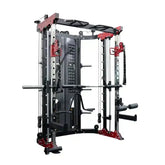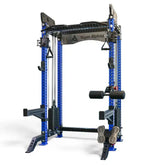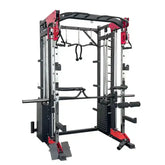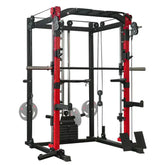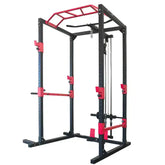Air Ski and Air Rower: Differences, Functions, and Training Areas
Both Air Ski and Air Rowing Machine are aerobic fitness machines that use the principle of air resistance, but they differ in movement patterns, primary functions, and targeted muscle groups.
1. Main Differences
|
Comparison |
Air Ski |
Air Rowing Machine |
|
Movement Pattern |
Simulates Cross-Country Skiing - pulling ropes downward with both arms |
Simulates Rowing - leg push, back pull & arm pull |
|
Body Posture |
Standing |
Seated |
|
Power Source |
Primarily upper body strength |
Combination of upper and lower body strength |
|
Workout Intensity |
Adjustable, suitable for high-intensity interval training (HIIT) |
Adjustable, suitable for endurance and power training |
|
Training Type |
Primarily upper body and core training, ideal for cardiovascular endurance |
Full-body endurance and strength training, especially for legs and back |
2. Main Functions
Air Ski
- Improves upper body strength and explosive power, especially in the shoulders, arms, and core.
- Enhances cardiovascular endurance, making it ideal for high-intensity interval training (HIIT).
- Suitable for skiers, cross-country ski enthusiasts, or athletes needing upper body endurance.
- Low impact, reducing stress on the knees and joints.
Air Rowing Machine
- Engages full-body muscles, particularly the legs, back, core, and arms, improving endurance and coordination.
- Boosts cardiovascular function and burns a high number of calories, making it an effective aerobic exercise machine.
- Strengthens the back muscles, improves posture, and enhances spinal stability, making it beneficial for people with back issues.
- Suitable for endurance training while also being useful for strength development.
3. Targeted Muscle Groups
|
Equipment |
Targeted Muscles |
|
Air Ski |
Shoulders (deltoids), arms (biceps, triceps), core (abs, back muscles), legs (quadriceps, hamstrings) |
|
Air Rower |
Legs (quadriceps, hamstrings, calves), back (latissimus dorsi, trapezius), core (abs, lower back), arms (biceps, triceps) |
4. Resistance Adjustment Through Air Resistance
Both machines adjust resistance proportionally to your effort level:
- The harder you pull, the faster the fan spins, and the greater the resistance.
- The softer you pull, the slower the fan spins, and the lower the resistance.
This means you can adjust your workout intensity in real time without needing fixed resistance levels like traditional fitness equipment.
5. Recommended Resistance Levels
|
Training Goal |
Suggested Level |
Suitable Equipment |
|
Endurance Training / Long Cardio (30+ minutes) |
3-5 |
Air Ski & Air Rower |
|
HIIT (High-Intensity Interval Training) |
5-7 |
Air Ski & Air Rower |
|
Explosive Strength Training |
7-10 |
Air Ski & Air Rower |
6. Which One Is Right for You?
- If you want to strengthen upper body power and cardiovascular endurance, choose Air Ski.
- If you prefer full-body workouts to improve endurance and strength, choose Air Rower.
- If you enjoy standing workouts, Air Ski is more suitable; if you prefer seated exercises, Air Rower is better.
- If you have knee or joint issues, Air Ski offers lower impact on the joints.

